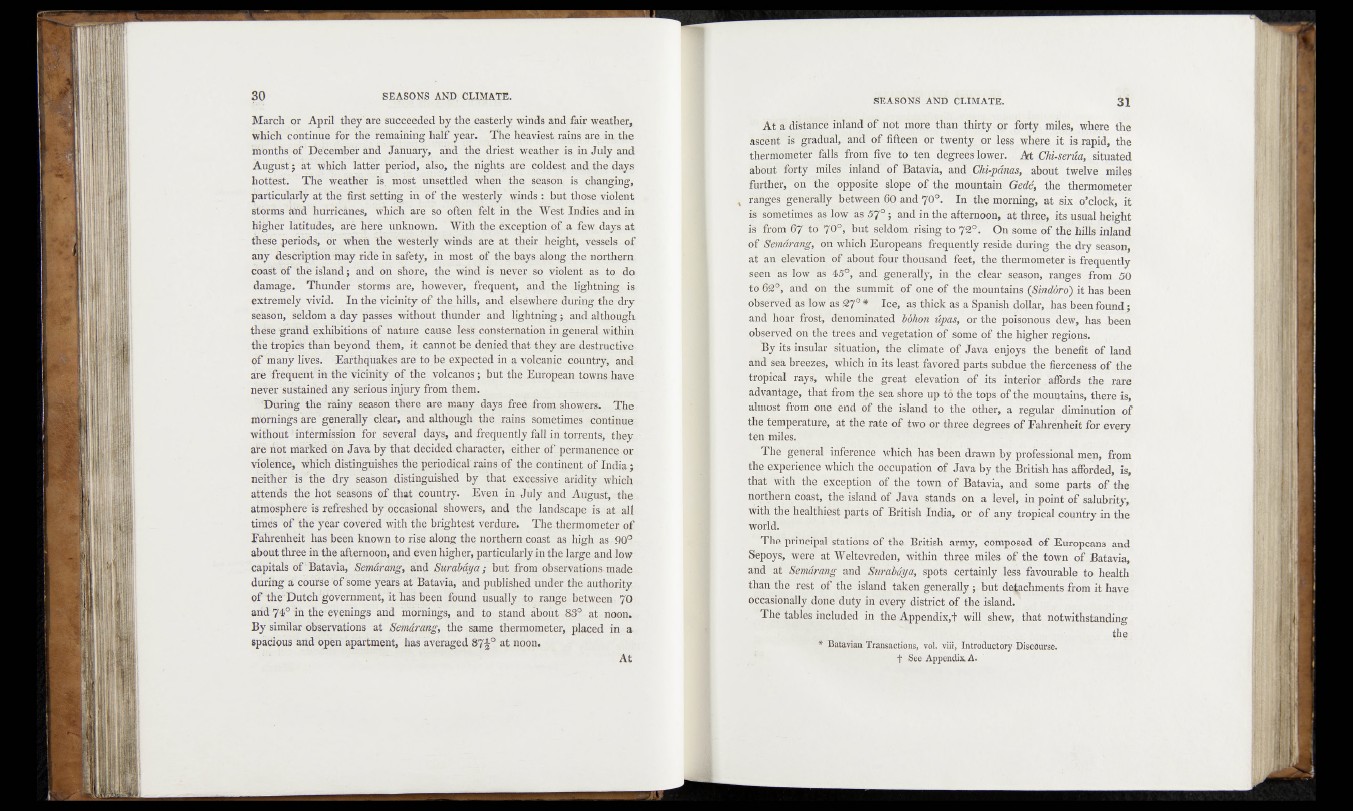
March or April they are succeeded by the easterly ydnds and fair weather,
Which continue for the remaining Halt year. _ The heaviest rain? are. in: the
ÏÓonths of’December and January, and the driest weather is in July and
August'; at Which latter period, also, the nights, are coldest and, the days
hottest. The weather is. most unsettled^ when' the season, is changing,
particularly at ‘the firât setting in, of thé westerly yyinds :, but thoses yiplent
storms àhd hurricanes, which are so often felt in, the Indies, and in
higher latitudes, arè here unknoyra, Wife the exception of .a few days at
these .periods, or when the Westerly winds ate. at -thçir height,. Vessel^ p£
any description‘may ride in safety, in most of thç bays along the northern,
coast "óf die island"; and on shore, the wind is never sp violent as to do
damage. Thunder storms are, however, frequent, apd the lightning, is
extremely vivid. In the vicinity of thefeiilsr arid, elsewhere during, the,'dry
season, seldom a day passes without thunder and lightning ;. and although
thèse grand exhibitions of nature came les? consternation in general within
it cannot be denigdfeat feey a^de^mctive
óf many lhes. Earthquakes are to, be expected in a vqlganiç country, and
are 'fréquent' in the'vicinity óf the volcanos ; but fee .European towns have
né^er ‘sustained' any sefióiis injury from them.
During the rainy season'there are many days freé, fron^ showers. The
tó'órnih^s are gènerally 'clear, and although the'rains sometini^ ïçônfinue
without' inf émission for'several days, and frequently faj], in* torrents, they
ate not marked ón Java by fhat decided, character, .either of. permanencemr.
vfoléhce, which distinguishes 'théperipdica! rains^of the .continent, of India
neiîhér Lis "the dry season distinguished by th^^^xqessivp ayjflity r.yhjch
attends the hot ' seasons of that ’ country. Even iifrjply fand August, KthcL
atmosphère1'ip'reft'eshéd'bjToccasional showers, and the landscape is-at-all
tintés of fee' ÿèàir c'aveïéd with the brightest verdure,. The .thermometer ofj
Fahrenheit has been known to rise «dong the, northernmost as high- as .90®
about three in the afternoon, and éven higher, particularly in the large and low
capitals óf "Batavia, - Semaràng, and Èuxabaya ; but, from observations-madè.
darihg' à- course 'of some years at Batavia, and published under the .authority,.
offerDutch’gôŸerriment, it has Been found usually to range hetween 'J'O
arid 74° ifi the:eytenings and mornings, and tp stand about §8? at noon.
By similar observations at Sekdmrig, the same thermometer, placed in a
SpaCious aüd open apartment, has averaged 87§° ait noon*
At
' At' a dîstàncë inland óf'riqf mçre than .‘thirty or forty miles, where the
asôen^i^raÜual,' and'oF fifteen or twenty^ or fe^ where jt is rapid, the
tH^fmo^^Jfalil jttotfefive to ten degrees jóyra:., At Chi-serûa, situated
afebSf^wt^mileS ] inland' of Batavia, mffîCM-pânap, about twelve miles
further,* pugHfe opposite slope of the mountain Gedés the thermometer
fanges^géne^® Between .60 fed'7®°-! w a h e morning, at six o’clock, it
is 'a? 57° », and in,the afternópri, at three, its usual .h eight
iMfroffîpi ^ y ÿ ô0', but seldom, rising Ön sofeepf the hill« inland
of^SÿhîafnnQ^^^mch Europeans feèquentiy fe^id'ejdurmg fee dry season,
af ai^e^aSbnoî^bdj|t four thousand feet, the thermometer is frequently
#Bfeffij$Ylow^ 45^ , and geperally, in; fet^Tear seaspn, ranges from if)
to affd’g ^ Jp^ sujrnmit ^of onë of the. mountains ,(Sindóro) it has been
dP8^Æ*iB™gasW^* ^Ic^J'as'thic^; as a Spanish, dopar,, has been found I
ahdj' nmr^roM, dfenofeinated bojiofi .zqpas, or the poispnqup dew, has been
obsëfved1 ^fjtnelCTcis'and.Vegetation ,ofr some of the higher regions.
situation, thÓ-climate,of Java enjoysr|the benefit of land
and1 sea,breezes;. which in its leasfifavored parts sub'due.the fierceness of .the
tropical raff?, ' ’Sjfeilè fee. great elevation/ofits Jnteirpr affords the rare
adyfefege, feat1 from fee. sea; sliore up to tfie,tops; of.the mountains, there is,
almqpt fföm mie'énd of the island to^the ^feer., a regular diminution of
the .temperature, ^ at the rate of, pwo or thrpe degrees ó f Fahrenheit for every
tetflniipk^w
jt^^^^enersilr inference which has been drawn by professional men, from
ffl^è'xpètfë^'wfecri the occupation of Java by the British has afforded, is,
t%^'with,thé "exception ófofee town of Batavia, and some parts of the
northern coast, fee island pf, Java stands .on V.level, _in point pf salubrity,
^ /S kèalfeiesè parts of British India, or of any tropical country in the
World/ '
The pnricipaVstatio^'s/of fee, Britife army, composed of Europeans and
^Ppy^j' were’' at Weltevreden, within three mile?- of the town of Batavia,
and at Sem'ârang and .Surabdya, spots .certainly less favourable to health
than the rest,of .fee island taken generally ;r but detachments from it have
occasionally.dope duty in every district of the island.
Thé tables included! in the Appendix,! will shew, that notwithstanding
the;
* Batavian Transaction's, vol. 'vlii, Introductory Discourse.
•• ;. -ifr~ See. Appendix A.